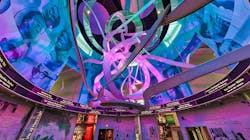5 African American Museums Share History & Culture Through Impactful Design
Museums dedicated primarily to African American history have long been a part of the American landscape. In places like Maryland, Mississippi, California and Washington, D.C., these museums have a separate and distinct style, each boasting a unique design and architectural elements that aim to preserve and celebrate African American culture and heritage.
From the iconic angled tiers of the National Museum of African American History and Culture to the bold black-and-white lettering in the lobby of the California African American Museum, their interiors and exteriors often tell a story and guide the visitor through an experience expertly crafted to be sobering, celebratory and hopeful. Take a look at how five museums around the country tell their stories through impactful design.
National Museum of African American History and Culture
Located on the National Mall in Washington, D.C., the National Museum of African American History and Culture captivates visitors from around the world with its three-tiered exterior – the tiers were inspired by crowns used in Yoruban art from West Africa. The entire building is wrapped with a bronze-colored metal lattice perforated with patterns. Lead designer David Adjaye’s intent was to pay homage to African American ironwork traditional of the South.
The museum is dedicated to the documentation of African American life, history and culture, and its interior focuses on themes of lightness and darkness. While sunlight spills in through the patterns from the metal lattice on the four aboveground galleries, much of the exhibits are underground. Adjaye intended for visitors to start their journey in the museum at the bottom and work their way up, reflecting the same journey African Americans have made from slavery to present day.
"In a way, the building is almost analogous to a giant tree with incredible shade," Adjaye told NRP’s Ari Shapiro in 2016. "I wanted it to be a museum where, when you come in, you weren't suddenly in an interior that was about focusing on marble and stone and classical forms ... but to come in and to have light be your guide."
California African American Museum
Although it’s been around since 1977, the California African American Museum didn’t find its permanent home until 1984. Today, it stands in Exposition Park near downtown Los Angeles. Currently on display at the museum is “California Bound: Slavery on the New Frontier, 1848-1865,” which examines the state’s under-recognized involvement with slavery in the nineteenth century.
History curator and program manager Tyree Boyd-Pates wanted to design an exhibit that was dynamic and immersive. The goal of the exhibit, he says, is to increase awareness of the history of enslavement in California in a time that encompassed two wars and the actual establishment of California as a territory and then a state.
“[The museum] has quite a diversity age-wise, so I had to make sure the exhibition could engage audiences and have several different entry points,” he says. Large murals adorn the walls and are overlaid with concise text. Boyd-Pates explains, “Hopefully visitors feel like history is towering over them and like they were around in that period of time.”
The National Memorial for Peace and Justice
Located in Montgomery, Alabama, The National Memorial for Peace and Justice is a sobering testament to the “legacy of enslaved black people, people terrorized by lynching, African Americans humiliated by racial segregation and Jim Crow and people of color burdened with contemporary presumptions of guilt and police violence.”
The Equal Justice Initiative (EJI) worked with MASS Design Group and artists like Kwame Akoto-Bamfo, a West African sculptor whose sculpture on slavery is on display as visitors enter the memorial. The site is well-known for its memorial square that features 800 six-foot monuments made of Corten steel that symbolize thousands of racial lynching victims in the U.S.
“Our nation’s history of racial injustice casts a shadow across the American landscape,” EJI director Bryan Stevenson explains in a press release. “This shadow cannot be lifted until we shine the light of truth on the destructive violence that shaped our nation, traumatized people of color and compromised our commitment to the rule of law and to equal justice.”
Using sculpture, art and design to contextualize racial terror through history, the memorial also features works from novelist Toni Morrison, words from Dr. Martin Luther King, Jr., and a reflection space in honor of Ida B. Wells-Barnett.
Reginald F. Lewis Museum of Maryland African American History & Culture
Nestled on Baltimore’s bustling Pratt Street, the Lewis Museum stands brightly and boldly with a black exterior splashed with red and yellow, colors emblematic of the Maryland flag. The red element is known as the Red Wall of Freedom, a 96-foot curved wall that cuts into the interior, meant to symbolize the “creativity, strong character and indomitable spirit of the Africans and their descendants.” Opened in 2005, the Lewis Museum is dedicated to the lives and history of African American Marylanders, with themes of family, community, slavery and art.
"What came through very clearly [from focus groups] is that they did not want a hand-me-down facility," former museum board vice chairman Aris Allen, Jr., told The Baltimore Sun in 2005. "African-Americans are tired of left-over seconds. We wanted a brand-new museum."
The Lewis Museum celebrates the lives of African American Marylanders and their contributions to society. On display this year is “Romare Bearden: Visionary Artist,” which highlights the artwork of Romare Bearden, a cartoonist and oil painter who was also a Harlem social worker in the 1930s.
Mississippi Civil Rights Museum
In Jackson, Mississippi, you’ll find the only state-operated civil rights museum in the country. The Mississippi Civil Rights Museum debuted in 2017, and its structure also houses the new Museum of Mississippi History (the original was destroyed by Hurricane Katrina). Architecture and design firm Perkins+Will designed the Civil Rights Museum, which focuses on the Mississippi Movement during the years of 1945 to 1970.
The two museums share a lobby, civic plaza and open-air courtyard. According to Perkins+Will, that interconnectedness “builds on the idea that conflicting lines of tension can converge and eventually lead to resolution and enlightenment.”
The gospel song “This Little Light of Mine” inspired the museum’s permanent exhibit, which is a 37-foot-high cylindrical sculpture that moves and lights up as more people enter its rotunda space. It symbolizes the brave people who descended upon Mississippi to fight for civil rights, bringing light to the darkness. “It’s a nice-size area, so you can breathe, so you can reflect, so you can think about what you saw,” museum director Pamela Junior told Mississippi Today.
As we celebrate Black History Month, consider a trip or two to one of these museums – or one of the number of other African American museums around the country – to see how design is shaping the way we preserve and celebrate African American history and culture.
► Design News | Why Diversity Initiatives Need a Data-Driven Approach

